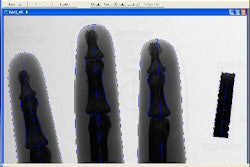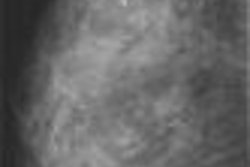VIENNA - The overarching goal of all radiography is to produce high-quality images with the lowest possible radiation dose to the patient. Research unveiled on Sunday at the European Congress of Radiology presented evidence that varying the anode/filter combination can affect both image quality and patient dose in full-field digital mammography (FFDM).
"Digital detectors have different absorption and a higher dynamic range than screen-film detectors," said Thomas Mertelmeier, Ph.D., of Siemens Medical Solutions (Erlangen, Germany), who presented the results of his group's investigations.
The team sought to optimize the radiographic technique for its amorphous selenium (a-Se) detector-based FFDM system (Mammomat, Siemens) by varying the combination of anode and filter material. The researchers employed a molybdenum (Mo)/Mo amalgamation, a Mo/rhodium (Rh) combination, and a tungsten (W)/Rh anode/filter grouping, respectively.
The researchers derived a figure of merit (FOM) as the squared signal difference-to-noise ratio divided by the mean average glandular dose. They tested exposure parameters with the anode/filter combinations in simulation and phantom-based experiments.
"The simulations, with both monochromatic x-rays and real spectra, took into account the absorption properties of the a-Se detector and scattered radiation, with and without grid, using Monte Carlo methods," Mertelmeier said.
The breast equivalent phantoms were comprised of three tissue composition variations -- 50% fat and 50% glandular, 70% fat and 30% glandular, and 30% fat and 70% glandular -- and four thickness differences of 2 cm, 4 cm, 6 cm, and 8 cm. A 0.1 mm aluminum disk was used to represent a lesion for simulations and measurements. Exposure time was one second on a focal spot size of 0.3 mm, according to Mertelmeier.
The team found that the W/Rh combination provided a higher FOM than either the Mo/Mo combination or the Mo/Rh combination. The simulation results were confirmed by the phantom experiments, Mertelmeier noted.
"With the thick phantoms, up to 50% less dose was sufficient to maintain a constant image quality," he said. "The advantages of the tungsten/rhodium combination increase with the larger compressed breast tissue."
The team's experience with Rh concurs with an earlier study (Physics in Medicine and Biology, July 2003, Vol. 48, pp. 1945-1956) on a GE Healthcare (Waukesha, WI) FFDM system that tested an Mo/Mo and Mo/Rh anode/filter combination. That team found that a combination of a standard Mo-anode 28 kVp radiograph with an Rh-anode 49 kVp radiograph provides the best compromise between image quality and dose in the hybrid image.
"A tungsten anode with rhodium filtration achieved a higher image quality than a molybdenum/molybdenum combination in our study," Mertelmeier said. "The tungsten anode with 50 µm rhodium filtration results in either better images or a saving in average glandular dose by up to 50% when compared with molybdenum/molybdenum."
By Jonathan S.
Batchelor
AuntMinnie.com staff writer
March 6, 2005
Related Reading
MCC finds no additional benefit for digital mammo, June 11, 2003
Key variables impact accuracy of digital mammography, April 21, 2003
Flat-panel unit beats CR for digital mammography, March 7, 2003
Study examines factors that affect FFDM performance, January 10, 2003
No compromise in breast image quality with lower FFDM dose, December 13, 2002
Copyright © 2005 AuntMinnie.com



















